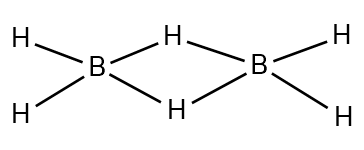
Answer
440.7k+ views
Hint: In the structure of diborane, there are two boron atoms and six hydrogen atoms and four hydrogens are terminal hydrogens while the other two are bridged hydrogens between the two boron centres. It is a highly unstable molecule.
Complete Solution :
- In the question we are asked to comment about the structure of diborane. It is a factual type question, in which we have to say about the structure of a diborane molecule.
So let’s brief discuss about diborane and its structure:
-Diborane is a chemical compound which consists of two borons and six hydrogens with the molecular formula ${{B}_{2}}{{H}_{6}}$.
-It is a colourless, pyrophoric gas which has a repulsively sweet odour.
-Diborane is highly unstable at the room temperature.
-And the compounds which consist of boron and hydrogen as the constituent atoms are called boranes.
-Diborane is one of the simplest boron hydrides.
- Diborane is a major boron compound which possesses a wide variety of applications. It finds a wide range of attention for its electronic structure. Its derivatives are useful reagents.
Now let’s discuss the structure of diborane.
- In diborane, as we know there are two born and six hydrogen atoms in which the four hydrogens are terminal hydrogens while the other two are bridged hydrogens, between the two boron centres. The four hydrogens are covalently bonded with the Boron atoms and hence there are two electrons present in the bond between the atoms. Therefore B - H bonds are 2c-2${{e}^{-}}$ bonds and there is 2c-2${{e}^{-}}$ bond.
- But the other two hydrogen atoms are bridged between the B-H-B bonds are 3c-2${{e}^{-}}$ bonds and there is two 3c-2${{e}^{-}}$ bonds.

- Hence, diborane has four 2c - 2${{e}^{-}}$ bonds and two 3c - 2${{e}^{-}}$ bonds. The length of the B – H bridge bond is 1.33$\mathop A\limits^ \circ $ and the length of B – H terminal bond is 1.19 $\mathop A\limits^ \circ $. This difference in bond lengths gives the answer for the difference in strengths of the bond. The B – H bridge bond is relatively weaker than the B – H terminal bond.
So, the correct answer is “Option A”.
Note: Remember that both the boron atoms in diborane are $s{{p}^{3}}$ hybridised. Also, the bridge bonds are relatively weaker than the terminal ones. ${{B}_{2}}{{H}_{6}}$ is a molecule species which is isoelectronic with ${{C}_{2}}{{H}_{6}}^{2+}$.
Complete Solution :
- In the question we are asked to comment about the structure of diborane. It is a factual type question, in which we have to say about the structure of a diborane molecule.
So let’s brief discuss about diborane and its structure:
-Diborane is a chemical compound which consists of two borons and six hydrogens with the molecular formula ${{B}_{2}}{{H}_{6}}$.
-It is a colourless, pyrophoric gas which has a repulsively sweet odour.
-Diborane is highly unstable at the room temperature.
-And the compounds which consist of boron and hydrogen as the constituent atoms are called boranes.
-Diborane is one of the simplest boron hydrides.
- Diborane is a major boron compound which possesses a wide variety of applications. It finds a wide range of attention for its electronic structure. Its derivatives are useful reagents.
Now let’s discuss the structure of diborane.
- In diborane, as we know there are two born and six hydrogen atoms in which the four hydrogens are terminal hydrogens while the other two are bridged hydrogens, between the two boron centres. The four hydrogens are covalently bonded with the Boron atoms and hence there are two electrons present in the bond between the atoms. Therefore B - H bonds are 2c-2${{e}^{-}}$ bonds and there is 2c-2${{e}^{-}}$ bond.
- But the other two hydrogen atoms are bridged between the B-H-B bonds are 3c-2${{e}^{-}}$ bonds and there is two 3c-2${{e}^{-}}$ bonds.

- Hence, diborane has four 2c - 2${{e}^{-}}$ bonds and two 3c - 2${{e}^{-}}$ bonds. The length of the B – H bridge bond is 1.33$\mathop A\limits^ \circ $ and the length of B – H terminal bond is 1.19 $\mathop A\limits^ \circ $. This difference in bond lengths gives the answer for the difference in strengths of the bond. The B – H bridge bond is relatively weaker than the B – H terminal bond.
So, the correct answer is “Option A”.
Note: Remember that both the boron atoms in diborane are $s{{p}^{3}}$ hybridised. Also, the bridge bonds are relatively weaker than the terminal ones. ${{B}_{2}}{{H}_{6}}$ is a molecule species which is isoelectronic with ${{C}_{2}}{{H}_{6}}^{2+}$.
Recently Updated Pages
Fill in the blanks with a suitable option She showed class 10 english CBSE

TISCO is located on the banks of which river A Tungabhadra class 10 social science CBSE

What is greed for clothes A Simply desire to have them class 10 social science CBSE

What does the 17th Parallel line separate A South and class 10 social science CBSE

The original home of the gypsies was A Egypt B Russia class 10 social science CBSE

The angle between the true north south line and the class 10 social science CBSE

Trending doubts
Fill the blanks with the suitable prepositions 1 The class 9 english CBSE

How do you graph the function fx 4x class 9 maths CBSE

Which are the Top 10 Largest Countries of the World?

Which is the longest day and shortest night in the class 11 sst CBSE

What is the definite integral of zero a constant b class 12 maths CBSE

Name five important trees found in the tropical evergreen class 10 social studies CBSE

The Equation xxx + 2 is Satisfied when x is Equal to Class 10 Maths

Differentiate between homogeneous and heterogeneous class 12 chemistry CBSE

Difference between Prokaryotic cell and Eukaryotic class 11 biology CBSE




